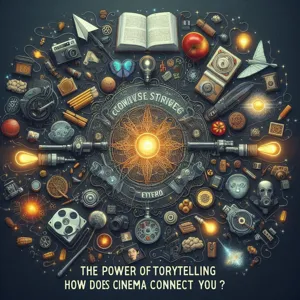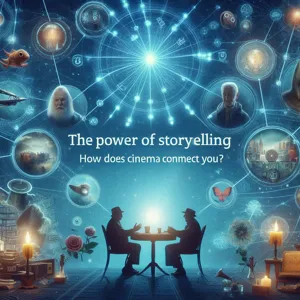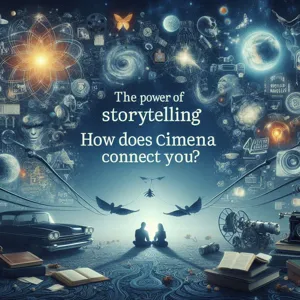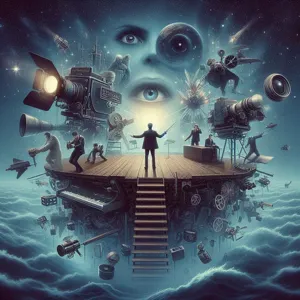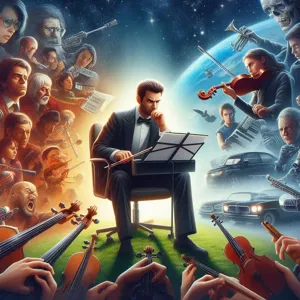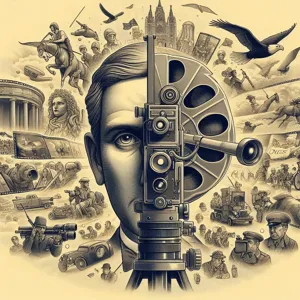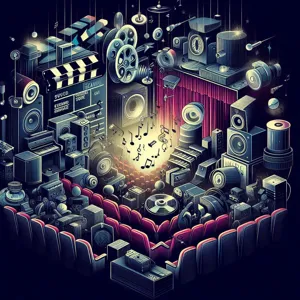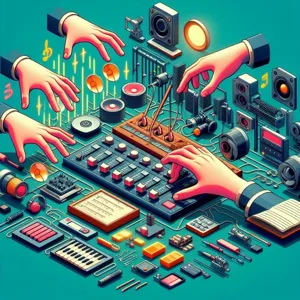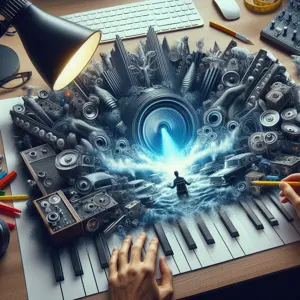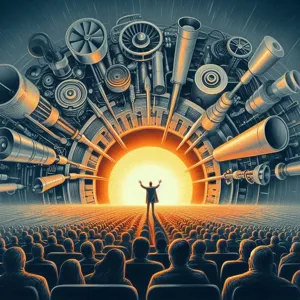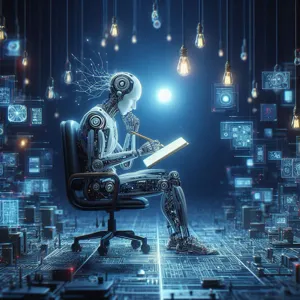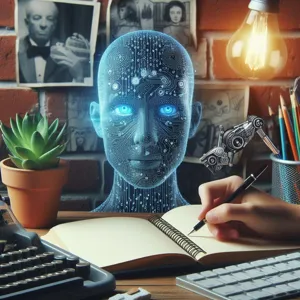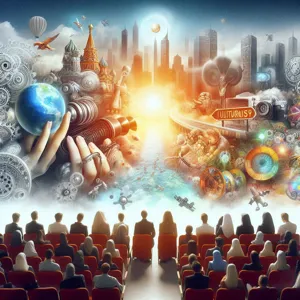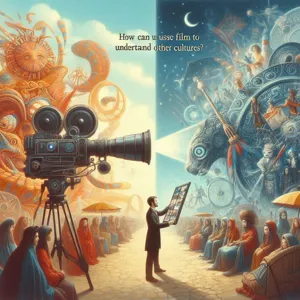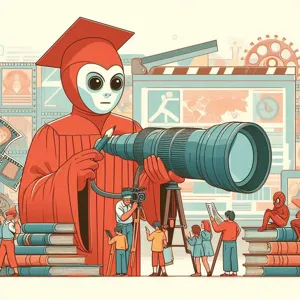In a world where screens dominate our daily lives, the magic of film transcends mere entertainment; it shapes our dreams, fuels our aspirations, and influences the very fabric of our imagination.
From the sweeping landscapes of epic adventures to the intimate moments in heartfelt dramas, movies have the power to transport us to realms beyond our reality, igniting passions and aspirations we may not have known existed. This exploration delves into the profound impact film has on our fantasies and the way it molds our desires, often reflecting cultural narratives and personal ambitions. As we unravel the intricate relationship between cinema and our innermost hopes, we’ll discover how stories told on the big screen inspire us to chase our dreams, challenge our perceptions, and sometimes even redefine our paths in life. Join us on this cinematic journey as we uncover the ways film not only entertains but also elevates our aspirations and shapes the dreams we dare to pursue.
1. Introduction: The Magic of Cinema and Its Influence
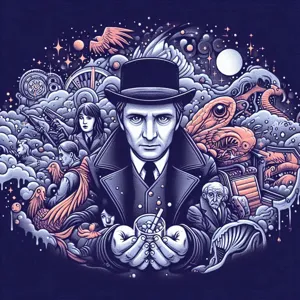
The flickering images on a screen have an unparalleled ability to transport us to other worlds, evoke emotions we’ve never felt, and ignite dreams we never knew we had. Cinema is more than just entertainment; it is a powerful medium that shapes our perceptions, aspirations, and fantasies. From the moment the lights dim and the first frame rolls, we are invited into a realm where anything is possible—heroes rise, love conquers all, and the unimaginable becomes reality.
Throughout history, films have served as mirrors reflecting societal values and personal journeys, often blurring the lines between fiction and reality. They inspire us, challenge us, and encourage us to question our own lives. Whether it’s the charming protagonist in a romantic comedy who dares to follow her heart, or the gritty hero in an action-packed thriller who fights against all odds, these characters resonate with our deepest desires and aspirations.
Moreover, the storytelling in cinema often acts as a catalyst for our dreams. It encourages us to envision a life beyond the mundane, pushing us to aspire for greatness and pursue our passions. As we sit in darkened theaters or huddle around our screens, we become part of something larger—an exploration of human experience that transcends time and culture.
In this blog post, we will delve into the fascinating interplay between film and our inner world, examining how narratives crafted by filmmakers not only entertain us but also influence our dreams and ambitions. From iconic films that have inspired movements to the subtle ways in which characters shape our views on success and happiness, our journey through the magic of cinema promises to reveal the profound impact it has on our lives. Join us as we explore the reel dreams that spark our imagination and fuel our aspirations, reminding us of the limitless possibilities that await beyond the screen.
2. The Role of Storytelling in Shaping Dreams
Storytelling has been a fundamental aspect of human culture for centuries, serving as a bridge between reality and imagination. In the realm of film, this age-old practice takes on a transformative power, shaping our dreams and aspirations in profound ways. Movies are not just a form of entertainment; they are a lens through which we explore the depths of our desires, fears, and ambitions.
When we immerse ourselves in a film, we are invited into a world where the extraordinary becomes ordinary, where the impossible is within reach. Through compelling narratives, filmmakers craft characters who face challenges, embark on epic adventures, and ultimately triumph over adversity. These stories resonate with us, reflecting our own struggles and aspirations. Whether it’s the underdog who rises to greatness, the love story that defies the odds, or the hero who saves the day, these cinematic journeys ignite our imaginations and inspire us to pursue our own dreams.
Moreover, storytelling in film often highlights themes of resilience, hope, and the pursuit of happiness. Consider the powerful message of a coming-of-age story, where a protagonist learns to embrace their true self and chase their passions. Such narratives encourage viewers to reflect on their own lives and consider what dreams are worth pursuing. The emotional connection we forge with the characters and their journeys can catalyze our own aspirations, prompting us to take that leap of faith or make a significant change in our lives.
Films also serve as a powerful mirror, allowing us to examine societal norms and expectations. They challenge us to dream bigger, to think beyond the confines of our everyday realities. Through diverse storytelling, we gain insight into different cultures, experiences, and perspectives, broadening our understanding of what is possible. This exposure can ignite a fire within us, motivating us to break free from limitations and strive for our own unique visions of success.
In essence, the storytelling found in film is a potent tool that shapes our dreams and aspirations. It allows us to envision a life filled with possibility, pushing us to turn our fantasies into tangible goals. As we leave the theater or close our streaming app, we carry with us the echoes of these narratives, reminding us that our dreams are not just figments of our imagination but reachable realities waiting to be realized.
3. How Films Reflect and Challenge Societal Norms
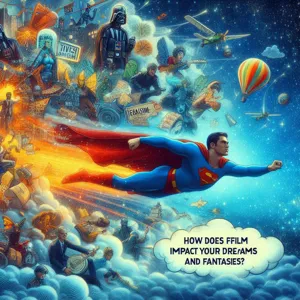
Films are powerful mirrors that reflect the multifaceted tapestry of society, capturing the zeitgeist of various eras while simultaneously challenging prevailing norms. From the gritty streets of 1970s New York in “Taxi Driver” to the vibrant, interconnected worlds of modern blockbusters like “Black Panther,” cinema has the unique ability to hold a lens to the issues that shape our lives, including race, gender, class, and sexuality.
At their best, films do more than just portray societal norms; they interrogate and critique them. Consider the feminist movements that have gained traction over the years; films like “Thelma & Louise” and “Little Women” are not merely stories about women—they are powerful commentaries on the societal expectations placed upon them. By showcasing characters who defy traditional roles, these films inspire audiences to envision alternatives to the status quo and encourage a re-evaluation of what is deemed acceptable or aspirational.
Moreover, films often serve as a catalyst for social change. The raw, unfiltered narratives found in documentaries like “13th” and “Won’t You Be My Neighbor?” not only shed light on critical social issues but also mobilize viewers into action. They challenge audiences to confront uncomfortable truths about systemic injustice and inequality, urging them to be part of the solution rather than passive observers.
Conversely, popular films can sometimes reinforce stereotypes and perpetuate harmful narratives, making it essential for viewers to engage critically with what they watch. By recognizing both the positive and negative portrayals in films, audiences can cultivate a deeper understanding of their own beliefs and aspirations, ultimately encouraging a dialogue around what it means to be part of a community.
As we explore the impact of film on our fantasies and aspirations, it becomes clear that cinema is more than just entertainment—it’s a dynamic force that shapes societal norms and pushes us to challenge them. Whether we find ourselves inspired by a character’s triumph over adversity or prompted to question the very fabric of our societal beliefs, films have the profound ability to not only reflect our world but to reshape it.
4. The Psychology Behind Film-Induced Aspirations
Film has a profound ability to shape our dreams and aspirations, often serving as a mirror reflecting our deepest desires and, at times, refracting them into something entirely new. The psychology behind film-induced aspirations can be attributed to several interconnected factors, including emotional resonance, identification with characters, and the allure of escapism.
At the heart of this phenomenon is the emotional connection that viewers establish with films. When we watch a character overcome adversity, achieve a seemingly impossible dream, or experience profound love, we don’t just observe these moments—we feel them. This emotional engagement can spark a sense of possibility within us, igniting ambitions we might never have considered. A young woman watching a film about a female entrepreneur might find herself inspired to pursue her own business venture, propelled by the triumphs and tribulations of the protagonist.
Moreover, the process of identification plays a crucial role in how films influence our aspirations. Audiences often see parts of themselves in the characters on screen, whether it’s their struggles, hopes, or dreams. This identification allows viewers to vicariously experience the character’s journey, making their achievements feel attainable. When we see relatable figures on the big screen—those who rise from humble beginnings or navigate life’s challenges—we perceive these stories as blueprints for our own potential success.
Escapism also contributes to the way films shape our aspirations. In an age dominated by routine and sometimes mundane realities, movies offer a gateway to extraordinary worlds and experiences that tantalize our imaginations. They allow us to break free from the confines of our daily lives, envisioning possibilities that extend far beyond our current circumstances. A fantastical adventure film might inspire us to pursue travel, exploration, or creativity, while a romantic drama could reignite a longing for love and connection, prompting us to seek deeper relationships in our own lives.
In essence, the psychology behind film-induced aspirations is a complex interplay of emotional engagement, character identification, and the desire for escapism. As viewers, we absorb these narratives, allowing them to intertwine with our personal experiences and aspirations. The impact of film extends far beyond mere entertainment; it can serve as a catalyst for self-discovery and a source of inspiration, urging us to chase our dreams with renewed vigor and conviction.
5. Iconic Characters and Their Impact on Personal Aspirations
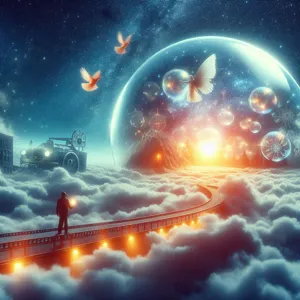
In the colorful tapestry of cinema, iconic characters serve as beacons of hope, resilience, and ambition, often shaping our personal aspirations in profound ways. From the daring hero who bravely confronts adversity to the wise mentor guiding the protagonist on their journey, these characters resonate with audiences, reflecting dreams that many hold close to their hearts. Think of characters like Rocky Balboa, whose relentless pursuit of victory against the odds inspires countless individuals to chase their own dreams, or Hermione Granger, whose intelligence and unwavering dedication encourage young minds to value knowledge and self-belief.
These larger-than-life personas not only entertain but also challenge us to envision possibilities beyond our current circumstances. They embody qualities that we admire and aspire to cultivate within ourselves, whether it’s courage, creativity, or compassion. As we watch them navigate their journeys—battling obstacles, facing fears, or achieving greatness—we often find a mirror reflecting our own desires and struggles.
Moreover, the influence of these characters extends beyond the screen. They become part of our cultural lexicon, shaping our conversations and social narratives. When we see a character succeed against all odds, it ignites a spark of ambition within us, pushing us to pursue our own goals with renewed vigor. The impact is not merely fleeting; it often propels individuals to take real-world actions, whether that’s starting a new career, embarking on a creative project, or advocating for change.
In this way, iconic characters act as catalysts for personal growth, encouraging us to dream bigger and reach higher. They remind us that, like them, we possess the strength and tenacity to overcome our challenges and turn our fantasies into realities. As we delve into the world of film, it becomes clear that these characters are far more than fictional figures; they are vital sources of inspiration that shape our aspirations and fuel our hopes for the future.
6. The Power of Genre: Fantasy vs. Reality in Film
When we delve into the realm of cinema, one of the most fascinating aspects to explore is the dichotomy between fantasy and reality, especially as it pertains to the genres that shape our dreams and aspirations. Films have an extraordinary ability to transport us to worlds far removed from our everyday lives, igniting our imaginations and challenging our perceptions of what is possible.
Fantasy films, with their enchanting landscapes, mythical creatures, and epic quests, allow us to escape the mundane and embrace the extraordinary. They invite viewers to envision lives filled with magic, heroism, and adventure. From the whimsical realms of Disney classics to the intricate universes crafted by filmmakers like Peter Jackson in “The Lord of the Rings,” these stories resonate with our deepest desires for adventure and purpose. They inspire us to dream beyond our current realities, often instilling a sense of hope and possibility.
On the other hand, films that lean heavily into realism—such as biopics or gritty dramas—offer a different kind of inspiration. They serve as powerful reminders of the struggles and triumphs of real individuals, showcasing the resilience of the human spirit. Movies like “The Pursuit of Happyness” and “Erin Brockovich” ground us in the understanding that while life may be fraught with challenges, perseverance and courage can lead to extraordinary outcomes. These narratives not only inspire us to chase our dreams but also provide a blueprint for overcoming obstacles in our own lives.
The interplay between these two genres can be particularly potent. A fantasy film can instill a sense of wonder, while a realistic narrative can encourage us to take tangible steps toward our aspirations. This blend of inspiration can be seen in films that dance between genres, combining fantastical elements with relatable characters facing real-world dilemmas, such as “Big Fish” or “The Secret Life of Walter Mitty.”
Ultimately, the power of genre in film is a reflection of our collective psyche. Whether we find solace in the whimsical escapism of fantasy or motivation in the stark truths of reality, films serve as mirrors to our desires and aspirations. They allow us to explore who we are and who we might become, encouraging us to embrace the dreams that dwell within us, regardless of whether they are rooted in the fantastical or the real. In this way, cinema not only entertains but also fuels our ambitions, prompting us to not only dream but to take action in pursuit of those dreams.
7. Case Studies: Films That Inspire Change and Ambition
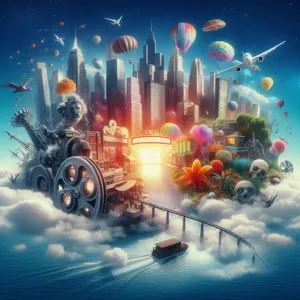
Films have long been a powerful medium to inspire change and ambition, transcending the confines of the screen to influence the hearts and minds of audiences around the world. In this section, we delve into a few remarkable case studies of films that have ignited passion and motivated individuals to pursue their dreams, overcoming obstacles along the way.
One of the most compelling examples is *The Pursuit of Happyness*, based on the true story of Chris Gardner, a struggling salesman who faces homelessness with his young son. This poignant narrative not only highlights the importance of perseverance and resilience but also serves as a testament to the human spirit’s capacity to withstand adversity. Viewers are left with a powerful message: success is attainable, no matter the hurdles in one’s path. The film’s impact is evident in the countless stories of individuals who have drawn inspiration from Gardner’s journey to chase their own dreams, often leading them to pursue entrepreneurship or greater aspirations in their careers.
Another film that has made waves in inspiring change is *Dead Poets Society*. The story of an English teacher, John Keating, who encourages his students to seize the day, challenges societal norms, and pursue their passions resonates deeply with audiences of all ages. Its themes of individualism and the pursuit of authenticity have empowered countless viewers to break free from societal expectations and follow their passions, whether that means pursuing art, literature, or unconventional careers. The film has inspired numerous educational reforms and discussions about the importance of fostering creativity and critical thinking in schools.
Lastly, *Hidden Figures* sheds light on the often-overlooked contributions of African American women in NASA during the space race. This film not only celebrates their extraordinary achievements but also highlights the importance of diversity and inclusion in the workplace. By bringing these remarkable stories to the forefront, *Hidden Figures* inspires viewers to advocate for equality and empowerment within their own communities and professional spheres, igniting ambition in those who find themselves in similar underrepresented roles.
These films are just a few examples of how cinema can spark profound change and ambition. They serve as reminders that stories have the power to inspire action, motivate dreams, and remind us of the limitless possibilities that lie ahead when we dare to chase our aspirations. As we explore the impact of film on our fantasies and ambitions, it becomes clear that the narratives we consume can shape not only our dreams but also the world around us.
8. The Influence of Biopics on Our Perception of Success
Biopics, or biographical films, have the unique power to shape our understanding of success by providing intimate glimpses into the lives of remarkable individuals. These films often portray not just the triumphs, but also the struggles, failures, and pivotal moments that define a person’s journey. By dramatizing the complexities of real lives, biopics serve as both inspiration and cautionary tales, influencing how we perceive the pathway to success.
Take, for instance, films like “The Pursuit of Happyness,” which chronicles the life of Chris Gardner, a man who faced homelessness while striving to create a better life for his son. Viewers are captivated not only by Gardner’s eventual success but also by the relentless perseverance required to overcome seemingly insurmountable obstacles. Such portrayals can instill a belief in the power of resilience and hard work, prompting audiences to re-evaluate their own aspirations and the sacrifices needed to achieve them.
Moreover, biopics often highlight the importance of mentorship and relationships in achieving one’s dreams. Films like “A Beautiful Mind,” which tells the story of mathematician John Nash, emphasize how collaboration and support systems can propel individuals toward success. By showcasing the interconnected nature of personal and professional journeys, these narratives encourage viewers to seek out mentors and foster relationships that can aid in their own pursuits.
However, it’s essential to approach these stories with a critical eye. While they can motivate and inspire, biopics can also present a glamorized view of success that overlooks the multifaceted realities of life. They may lead us to believe that success is a linear journey, forgetting that it often involves detours, failures, and moments of doubt. As we watch these films, it is crucial to reflect on the lessons they impart while recognizing that our own paths may differ significantly.
In essence, biopics are more than just a source of entertainment; they are powerful cultural artifacts that influence our aspirations and perceptions of success. They remind us that while the road may be fraught with challenges, it is the human spirit’s capacity for resilience, innovation, and connection that ultimately paves the way for our dreams.
9. Escapism in Film: How It Shapes Our Fantasies
Escapism in film has long been a powerful draw for audiences, providing a much-needed refuge from the often monotonous or stressful realities of everyday life. When we immerse ourselves in the vibrant worlds crafted by filmmakers, we are transported to realms where anything is possible — from dazzling adventures in fantastical lands to profound journeys of self-discovery. This ability of film to whisk us away plays a crucial role in shaping our fantasies and aspirations.
Consider the lush landscapes of a romantic comedy set in Paris, where love blooms effortlessly beneath the Eiffel Tower, or the thrilling escapades of a superhero saving the world from certain doom. These narratives not only entertain but also ignite our imaginations, encouraging us to dream bigger than our circumstances might suggest. They present archetypes and ideals that resonate deeply with our desires — be it the pursuit of romance, adventure, or heroism.
Moreover, escapism through film can offer audiences a means to explore aspects of themselves that may remain dormant in their daily lives. A shy individual might find inspiration in a daring protagonist who conquers fears and embraces spontaneity. A person grappling with uncertainty may see their aspirations reflected in a character’s relentless quest for success. These cinematic experiences become windows into possibilities, allowing viewers to envision lives beyond their own.
The immediate gratification that comes from these fantastical narratives can also influence our long-term goals. As we repeatedly engage with these stories, the aspirational elements seep into our psyche, shaping our values and desires. We begin to emulate the characters we admire, adopting their confidence, resilience, and creativity in our own lives.
In essence, the escapism provided by film serves as a catalyst for our dreams, reminding us that life can be as exhilarating as any movie plot. It encourages us to cultivate our fantasies, embrace our ambitions, and dare to step beyond the confines of our reality. Whether it’s through the thrill of adventure, the warmth of love, or the pursuit of justice, film has the remarkable ability to inspire us to reach for our dreams, transforming our fantasies into tangible aspirations.
10. The Role of Cinematography in Evoking Aspirations
Cinematography is more than just the art of capturing moving images; it’s a powerful tool that shapes the way we perceive stories and influences our dreams and aspirations. The visual language of film—composed of camera angles, lighting, color palettes, and movement—works in harmony to create an emotional landscape that resonates deeply with viewers.
When we think of iconic films that have inspired countless individuals, we can often attribute much of their impact to exceptional cinematography. For instance, the sweeping landscapes of “The Lord of the Rings” not only transport us to Middle-earth but also ignite a sense of adventure and possibility. The meticulous attention to detail in each frame evokes feelings of grandeur and wonder, making us yearn for our own epic journeys.
Moreover, cinematography can depict the nuances of human emotion, capturing moments that inspire empathy and connection. In films like “The Pursuit of Happyness,” the intimate close-ups of the protagonist’s struggles and triumphs invite us to reflect on our own challenges and aspirations. The use of light and shadow in these scenes adds depth to the character’s journey, compelling us to root for their success and, in turn, motivating us to chase our dreams relentlessly.
Color also plays a significant role in evoking aspirations through cinematography. Bright, vibrant hues can instill a sense of joy and hope, while darker tones might symbolize struggle or introspection. Think of a film like “La La Land,” where the rich, saturated colors create a dreamlike quality that mirrors the characters’ artistic ambitions and romantic longings. This visual storytelling encourages audiences to embrace their passions and pursue creative endeavors, reminding us of the beauty and excitement that can come from following our dreams.
In essence, the role of cinematography in film transcends mere aesthetics; it is a catalyst for inspiration. As we watch characters navigate their worlds, overcome obstacles, and chase their dreams, we can’t help but reflect on our own aspirations. The mesmerizing visual techniques used in filmmaking invite us to dream bigger, reach higher, and believe that our own stories can unfold in extraordinary ways. Through the lens of a camera, our fantasies are not just depicted; they are awakened, urging us to turn our aspirations into reality.
11. The Impact of Film Soundtracks on Emotion and Aspiration
The emotional landscape of a film is often sculpted not just by visuals, but profoundly by its soundtrack. A well-crafted score can elevate a scene, turning a simple moment into an unforgettable experience. Think of the swelling strings during an emotional climax or the rhythmic beats that accompany a thrilling chase; these auditory elements are not just background noise but powerful tools that influence our feelings and ignite our imaginations.
Film soundtracks have the ability to evoke a wide range of emotions, from joy and nostalgia to melancholy and fear. Composers like Hans Zimmer, John Williams, and Ennio Morricone have mastered the art of using music to enhance storytelling, creating sonic landscapes that resonate deeply with audiences. For instance, the haunting melodies in “The Lion King” transport us back to childhood dreams of adventure and heroism, while the triumphant themes in “Star Wars” inspire aspirations of courage and rebellion against the odds.
Moreover, soundtracks often become anthems for personal aspirations. Songs from films frequently find their way into our playlists, serving as motivational soundtracks in our daily lives. When we hear that rousing theme from a beloved movie, it can stir up dreams of greatness, pushing us to pursue our own paths with the same fervor as the characters on-screen. Whether it’s the empowering notes of “Eye of the Tiger” from “Rocky” or the whimsical tunes of “La La Land,” these soundtracks can serve as reminders of our ambitions, encouraging us to chase our dreams with renewed vigor.
In an age where streaming services allow us to curate our own musical experiences, film soundtracks remain a vital part of the audio tapestry that shapes our aspirations. They remind us that while the stories we see on screen are fictional, the emotions they evoke and the dreams they inspire are very much real. By tapping into the evocative power of film music, we can find motivation, solace, and a sense of connection to the narratives that fuel our own life journeys.
12. How Films Address Dreams of Different Cultures
Films are a powerful medium that transcends borders, weaving a tapestry of dreams and aspirations that reflect the diverse cultures of our world. Each cinematic narrative carries within it the unique hopes, fears, and desires of its cultural backdrop, offering audiences a glimpse into the collective consciousness of different societies. From the vibrant streets of Bollywood to the haunting landscapes of Scandinavian cinema, films encapsulate the dreams that resonate with their cultural origins while also challenging and redefining them.
For instance, in many Western films, the archetype of the “American Dream” is a prevalent theme, portraying narratives of individualism, success, and the relentless pursuit of happiness. Characters often embark on journeys that symbolize their struggle against societal constraints, with the ultimate goal of achieving personal fulfillment and wealth. In contrast, Asian cinema frequently emphasizes the importance of community and family, presenting dreams that are often intertwined with the collective aspirations of the group rather than the individual. Films like “Spirited Away” showcase how personal dreams can reflect broader cultural values, such as respect for tradition and the importance of familial bonds.
Moreover, indigenous cinema sheds light on the dreams of marginalized cultures, providing a platform for voices that have long been silenced. Films that emerge from these communities often explore themes of resilience, identity, and the reclamation of cultural heritage, illustrating a deep connection to the land and ancestral roots. Through storytelling, these films not only address personal and cultural dreams but also serve as powerful tools for social change, challenging stereotypes and fostering understanding.
As we explore the dreams portrayed in films from various cultures, we are reminded of the universal human experience of aspiration. While the specifics of these dreams may differ, the underlying emotions—hope, desire, and the quest for belonging—remain the same. By engaging with these diverse narratives, we not only broaden our perspectives but also find new ways to relate to our own dreams and aspirations, creating a rich tapestry of shared human experience that transcends cultural boundaries. Ultimately, films are more than just entertainment; they are reflections of our dreams, offering insights into the aspirations that shape our lives and the world around us.
13. The Evolution of Film and Its Changing Impact on Aspirations
The evolution of film has been a fascinating journey, reflecting not only technological advancements but also shifts in societal values and aspirations. From the silent black-and-white films of the early 20th century to the vibrant, high-definition spectacles of today, cinema has continually adapted to the cultural zeitgeist, shaping and reshaping our dreams along the way.
In the early days, films often served as simple escapism, transporting audiences to fantastical worlds where heroes triumphed against all odds. These narratives, filled with adventure and romance, tapped into the collective yearning for a life beyond the mundane, inspiring viewers to aspire for greatness in their own lives. The rise of Hollywood’s Golden Age brought with it a wave of glamorous stars and grand narratives, setting a standard for success that many sought to emulate.
As the decades rolled on, the themes explored in film began to diversify, mirroring the complexities of modern life. The 1960s and 70s introduced more nuanced stories, where protagonists grappled with moral dilemmas and societal issues, reflecting a growing awareness of the world’s imperfections. This shift prompted audiences to aspire not just for personal success, but also for societal change—fueling movements for civil rights, gender equality, and environmental awareness.
With the introduction of independent cinema in the 1990s and the rise of digital platforms in the 2000s, filmmakers began to explore a broader range of voices and experiences. This evolution has allowed previously marginalized stories to take center stage, inspiring new generations to pursue their unique paths and champion their causes. Films like *Moonlight* and *Parasite* challenge traditional narratives and encourage viewers to dream beyond the conventional success stories, highlighting the power of identity and social justice.
Today, as we navigate an era dominated by digital content and streaming services, the impact of film on our aspirations continues to evolve. The rise of social media has transformed the way stories are told and shared, allowing audiences to engage directly with creators and become active participants in the storytelling process. This interactivity fosters a sense of community and belonging, encouraging individuals to explore their dreams collectively rather than in isolation.
The evolution of film is not just about technological advancements; it’s a reflection of our changing aspirations and the values we hold dear. As films continue to push boundaries and challenge norms, they shape not only our fantasies but also our understanding of what is possible. In this ever-changing landscape, one thing remains clear: cinema will always hold a mirror to our hopes and dreams, inspiring us to reach for what lies beyond the horizon.
14. Conclusion: The Lasting Effects of Film on Our Lives
As we draw the curtain on our exploration of film’s profound impact on our fantasies and aspirations, it’s evident that movies do more than just entertain; they shape our very understanding of the world and ourselves. From the grand epic that ignites our sense of adventure to the poignant indie films that evoke our deepest emotions, cinema serves as a mirror reflecting our dreams, fears, and desires.
Films have the unique ability to transport us to different realms, allowing us to experience lives we may never lead. They inspire us to chase after our own ambitions—whether it’s becoming an artist, a leader, or a pioneer in a field we’re passionate about. Characters become archetypes, embodying traits we aspire to, and their journeys resonate with our own paths, encouraging us to persist in the face of adversity.
Moreover, the power of storytelling in film goes beyond individual aspirations; it fosters community and connection. Shared experiences in darkened theaters can ignite discussions, spark friendships, and create movements that transcend the screen. As we leave the theater, we carry with us not just the memories of the film, but also a renewed sense of purpose and the courage to dream bigger.
In a world increasingly dominated by fleeting digital content, films remind us of the magic of storytelling and its ability to influence our lives profoundly. They encourage us to reflect on our own narratives and the roles we play within them. As we continue to watch and create, let us embrace the transformative power of film, allowing it to guide our dreams and aspirations, for it is in the stories we tell and the dreams we dare to pursue that we find the essence of our humanity.
15. Call to Action: How to Use Film as Inspiration in Everyday Life
As we wrap up our exploration of the profound impact film has on our dreams and aspirations, it’s time to consider how we can harness this inspiration in our everyday lives. Film, with its powerful storytelling and visual artistry, serves as a wellspring of motivation, urging us to pursue our passions, confront our fears, and embrace our unique journeys.
### Call to Action: How to Use Film as Inspiration in Everyday Life
Start by curating a list of films that resonate with you personally. Whether it’s a classic that shaped your childhood or a contemporary masterpiece that challenges societal norms, each film holds the potential to ignite your creativity and spark introspection. Set aside time each week to watch one of these films, allowing yourself to be immersed in the narratives and themes that evoke your aspirations.
Next, consider journaling your thoughts and feelings after each viewing. What emotions did the film stir within you? Did it remind you of a dream you once had or a passion you’ve sidelined? Writing down your reflections not only deepens your engagement with the film but also helps you to articulate your aspirations more clearly.
Additionally, don’t hesitate to share your insights with others. Discussing films with friends or joining local film clubs can create a supportive community where aspirations are nurtured and encouraged. You may find that others share your dreams or have their own stories of inspiration drawn from the same cinematic experiences.
Finally, take actionable steps inspired by what you’ve seen on screen. If a film features a character who pursues their passion against the odds, let that motivate you to take a class, start a project, or even just reach out to someone who can help you on your journey. Film is not just a source of entertainment; it is a catalyst for action. Embrace the power of cinema to transform your fantasies into reality, and let each film guide you toward a life that reflects your highest aspirations. After all, the stories we watch can inspire us to write our own.
As we conclude our exploration of the profound impact film has on our fantasies and aspirations, it’s clear that cinema serves as more than just a source of entertainment; it acts as a powerful catalyst for inspiration and imagination. The stories we see on screen can ignite our dreams, challenge our perspectives, and encourage us to pursue our passions with renewed vigor. Whether it’s the allure of adventure, the triumph of the underdog, or the beauty of love, films have an unparalleled ability to resonate with our deepest desires. As you continue to watch and cherish your favorite movies, take a moment to reflect on how they shape your own ambitions and dreams. We invite you to share your thoughts and experiences in the comments below—what film has inspired you the most? Your journey in the world of cinema is just beginning, and we can’t wait to see where it takes you.


